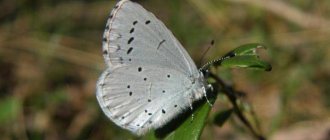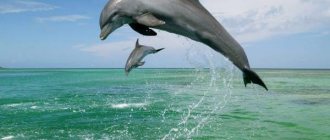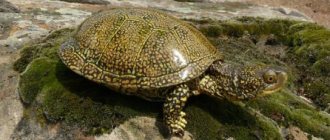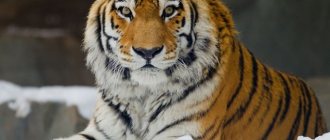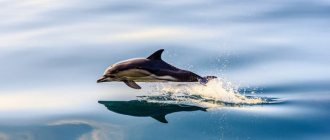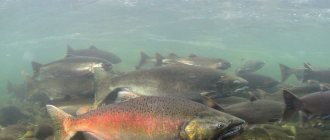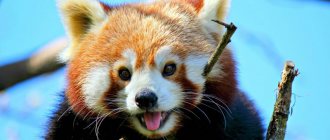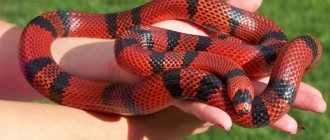The Black Sea bottlenose dolphin was included in the order “cetaceans” of the class mammals. She belongs to one of the varieties of dolphins. The habitat of the Black Sea bottlenose dolphin is the Black Sea and areas in the World Ocean with warm waters. “Big dolphin” is the name of the Black Sea bottlenose dolphin, and it is designated by the name “Tursiops truncatus” in the classification.
Appearance and features
The Black Sea bottlenose dolphin was classified as a species of toothed whale. She has up to two hundred small conical teeth in her mouth. With their help, the bottlenose dolphin captures fish, crustaceans and mollusks.
The structure of the head of the Black Sea bottlenose dolphin is specific:
- an elongated muzzle with a frontal part hanging over it, a rounded nose;
- the head is small, but the brain located in the skull weighs 1700 grams;
- the breathing holes are located in the upper region of the head.
The body length is from two to three and a half meters. The weight of an adult bottlenose dolphin is 300 kilograms. The upper part is dark gray or brown, and the belly is beige-white. The bottlenose dolphin has fins on its chest, back and tail. The sounds made by dolphins have their own characteristics: syllables and even phrases stand out in them.
Sounds: Dolphin
The head of the mammal is about 59 cm, the palate has a flat shape without grooves. The dolphin's teeth are strong and quite sharp, the length ranges from 7 - 10 mm thick, 20 - 29 pairs are on the upper jaw and 1 - 3 pairs less on the lower jaw.
This means that there are gaps between both rows of teeth and when the jaws slam shut, the teeth of the upper row move into the spaces between the teeth of the lower row. In other words, if the prey is caught in the mouth of a mammal, then it has no chance.
I invite you to visually compare the actual dimensions of an adult bottlenose dolphin with the dimensions of a scuba diver swimming above it.
Bottlenose dolphin and scuba diver photo.
Animals do not have sweat glands, all that a mammal's body can rely on, this is in fat accumulations, in the abdominal cavity and throughout the body, but in small quantities. They exchange heat with the environment through their fins:
- Breasts;
- Dorsal;
- Tails;
There are known cases when a dolphin was thrown ashore by waves, its body along with its fins overheated, and the animal simply died.
There is also such a feature of the dolphin’s fins; even if the animal is rescued and returned to its usual habitat, the fins may lose their functionality due to severe overheating, which also threatens it with inevitable death.
Lifestyle and reproduction
Black Sea bottlenose dolphins are united in small groups, each of which performs its own functions. Basically, groups are formed by age. The largest males are the leaders.
At five to six years old, the bottlenose dolphin is able to reproduce. Mating occurs in autumn and spring. For almost two weeks the male has been courting the female: he squeals, swims around her, presses his head against her and strokes her with his fins.
Pregnancy lasts about a year. After the baby is born, the family rises with him to the surface of the water so that he takes a breath of air. The female feeds the cub with milk for about eighteen months. After birth, the newborn may not sleep for a month.
Animals produce audio signals for communication and ultrasonic signals for orientation. They are socially conscious and emotionally concerned about their fellow humans. The Black Sea bottlenose dolphin reaches speeds of up to fifty kilometers per hour, and its life expectancy is 25 years.
Bottlenose Dolphin Lifestyle
Bottlenose dolphins live in many parts of the planet, prefer warm waters, but are found in the Norwegian, Red Sea, near Greenland, as well as in the Mediterranean Sea, near Japan, New Zealand and Argentina.
Dolphins have a sedentary lifestyle, but can wander in search of food. Schools of dolphins are divided into small groups according to age. Each group has functions. However, mammals tend to be solitary for unknown reasons. Sometimes individuals leave the flock for a while and then return. In captivity, the dolphin hierarchy becomes stricter. The leaders are the older males of large size.
There are 7,000 individuals of the Black Sea mammal living in the Black Sea. However, their numbers are constantly decreasing due to gas and oil production, shipping, and poachers.
Nutrition
Bottlenose dolphins get their food mainly in the coastal zone, but sometimes hunt at depths reaching more than a hundred meters. The ability to pause breathing while moving at high speed allows them to obtain food at depth. The diet of bottlenose dolphins includes:
- shellfish;
- octopuses;
- bottom fish.
Black Sea bottlenose dolphins go hunting in flocks. Adult dolphins eat up to 14 kg of food during the day.
Where to look
In the sea
Dolphins can be seen almost everywhere, but not everyone succeeds. It is best to go on a tour early in the morning on a yacht. You will be able to watch the Black Sea dolphins in their natural habitat; most often on the coast you can find white-sided dolphins, which behave much more playfully than bottlenose dolphins. This is better than a dolphinarium - during a boat trip you can communicate with sea creatures at arm's length and take memorable pictures. We have an individual dolphin tour in Sochi lasting 3 hours.
At the dolphinarium
Another option is to visit the dolphinarium. Here the inhabitants live in specially equipped enclosures. You can catch a show or swim with the Black Sea bottlenose dolphins, but you won’t see white-sided and azovka dolphins here.
Interesting Facts
- Bottlenose dolphins are friendly towards humans. There have been cases when they saved people from a shark, surrounding him with the entire flock and not letting the shark near him until the moment of rescue.
- Each animal has a name that its relatives call it. Bottlenose dolphins use words, syllables and phrases in their vocal communication.
- Animals have poor vision, but their hearing is unique: they perceive sound waves in a wide range of frequencies. Bottlenose dolphins have highly developed intelligence: they understand gestures, imitate human movements, store symbols in their memory, and recognize themselves in mirror images.
Character of bottlenose dolphins
Bottlenose dolphins are as trainable as dogs, demonstrate incredible tricks and are friendly to humans in captivity. Even in their natural environment, they show interest in people and often make contact. Bottlenose dolphins are characterized by a strong attachment to humans. If you release a dolphin that has lived in a dolphinarium for a long time into the wild, it will not swim far from this place. The trainability of bottlenose dolphins has made them in demand in the navy. The military uses them as aquatic “dogs”: video surveillance and photography, delivery of explosives.
Bottlenose dolphins are easy to train
Since 1966, catching bottlenose dolphins in the Black Sea in Russia has been prohibited. The Black Sea bottlenose dolphin is in the International Red Book. But every year, dozens of dolphins are killed in poachers' nets, while others die from being close to tankers and other industrial ships.
Number of animals
Black Sea dolphins (photos are given in the article), unfortunately, have a small number. A huge number of them have been destroyed over the last century. Their catch at one time was so enormous that it did not have the best effect on the population. The meat of the animals was used to make sausages, and the bones were ground and used as fertilizer, as well as in soap making and medicine.
In the last decade, dolphins along the Black Sea coast have reduced their numbers. Almost 6 million individuals were destroyed. Currently, the exact number of these beautiful creatures is unknown.
Even after the cessation of fishing, the main danger for bottlenose dolphins, as well as for other inhabitants of the sea, was environmental pollution. In addition, the increase in shipping did not have the best effect. Dolphins often get caught in nets and become entangled in them, and they cannot get out of them on their own. Poaching also causes harm.
The man-made problem is no less detrimental. Noise pollution from oil platforms, radars, ships and underwater explosions reduces their numbers. Bottlenose dolphins lose all orientation in space, as a result of which they are thrown onto the coast en masse.
This is interesting: Dolphins of the Black Sea: photos, what species live, are they dangerous
Coastal show for tourists
Many vacationers in Crimea dream of seeing dolphins. The easiest way to do this is to go to the dolphinarium for a modest fee (there you can even meet the artists in person and take photos with them). But such objects are still created by people, therefore, most vacationers believe that the sight of a dolphin in its native element will be much more interesting.
There is nothing impossible about this. Since bottlenose dolphins prefer to hunt during the day and in shallow water, they often come close to the shore. Of course, it’s rare to see them near crowded beaches or city promenades - there are no fish, and there’s a lot of noise. But this also happens (in particular, dolphins are often observed from the embankment in Sudak). The chances are even better on wild beaches in deserted bays. The only problem is the unpredictability. You can also see these animals during sea excursions. They are curious, they just swim up to see what the travelers are doing.
It doesn’t hurt tourists to write down the telephone numbers of the “dolphin ambulance” - it is provided by the leading Crimean dolphinariums, because even a random passer-by can find a wounded bottlenose dolphin on the beach. Using the emergency number, you can call a specialized veterinary car to the dolphin. And first aid to the victim should be to wet his fins with water - otherwise he risks dying from overheating.
Brothers in mind for man
The Black Sea bottlenose dolphin is also an object for scientific research - its sociability contributes to this.
Scientists are trying to understand the way dolphins think, decipher their language and achieve mutual understanding with them. These creatures are the only ones on the planet that are truly close to us in terms of their level of intellectual potential.
Military programs with the participation of bottlenose dolphins are not currently being implemented in Crimea - there were such programs before. But research on their possibilities in medicine is progressing successfully; there have been significant achievements in this area. Dolphin therapy has already been successfully used, in particular, for infantile paralysis and autism.
Scientists are confident that they will eventually be able to come to an agreement with bottlenose dolphins, and humans will no longer be considered the only intelligent species on the planet.
Reviews from those who were lucky enough to see Black Sea bottlenose dolphins in the wild are unanimous: no description can convey the cheerful charm of this picture. This is a chance for humans to become better, and for dolphins to survive.
